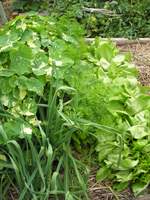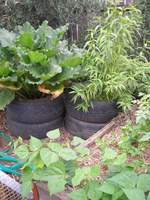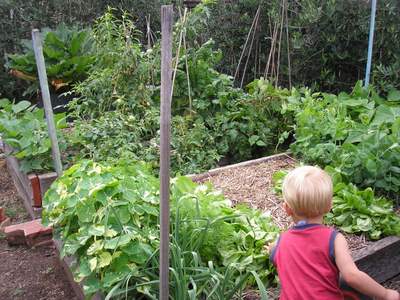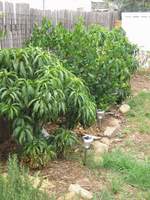|
A Raised Bed Vegetable Garden for KidsAnnette and Kim’s Kid-Friendly Home Vegetable Garden
Including a raised bed vegetable garden in your backyard is an ideal way to foster your children’s interest in home vegetable gardening. The fresh vegetables grown in Annette and Kim’s kid-friendly home vegetable garden rarely make it from the veggie patch to the kitchen table. The kids snack while they play, which doesn’t trouble Annette at all. “That’s what we have it for,” she says.
Making a raised bed vegetable garden accessible to kidsAnnette and Kim’s suburban veggie patch demonstrates that a small area can be made productive and kid-friendly when it’s integrated well with other parts of the garden. Within 10 square metres are 2 large raised vegetable garden beds, 4 tyre stacks, a compost bin, a worm farm, a chook tractor and a small greenhouse. Also nearby is the kids potting bench, which doubles up as an insect collecting bay. The vegetable patch is positioned in the back corner of the yard, opening onto the children’s play area. Annette and Kim’s intention was to make the raised bed vegetable gardens accessible to the kids, so that they feel it is a part of their space and share ownership and responsibility for the food-yielding plants in their garden. This has developed their awareness and appreciation of the food cycle. Planting vegetables for kids to eat and experiment with
The kids all have their favourites that they eat directly from the vegetable patch. Beans, peas, snowpea shoots, nasturtium flowers, tomatoes, carrots, blueberries and raspberries are fair game. Annette grows extra spinach for the kids to pick and share with their rabbits and chooks. She likes the idea that they are learning to share what they grow. Nasturtiums are grown as pest-deterrents but they don’t deter the kids; they like to snack on the flowers. Each growing season, Annette plants the kids’ solid favourites but also adds new varieties of vegetables for them to try. Last year they tried radishes, but the flavour was too hot to be popular with the kids. This year they’re experimenting with purple beans and butter beans alongside the green bean, snowpea and sugar snap favourites. The raised bed vegetable garden also contains beets, tri-coloured rhubarb, garlic, carrots, capsicum, silverbeet, tomatoes (Tiny Tim, Grosse Lisse and Black Russian), potatoes (Kipfler and Pontiac), peas and nasturtiums. The kids are so successfully involved in the vegetable gardening process that it’s the only space in the yard they’re willing to weed. This is partly because they can snack while they work. The only time Kim gets cranky about the kids in the garden is when they pull out seedlings while they’re ‘weeding'. Layout of the vegetable garden
When Kim and Annette originally planned their vegetable garden, the plan was sketched out and crop rotation schedules included in the design. With five kids to manage some of that planning has had to be set aside for practical considerations, but the basic design still holds. There are two raised bed vegetable gardens side by side, flanked by four tyre stacks for vegetables such as potato, rhubarb and tomatoes.
One bordering fenceline is planted with olives as a screen, and the other is planted with fruit trees to be espaliered along the fence; a dwarf nectarine, a dwarf peach, Gala apple, Angelface peach and Maya lemon. Rather than having a formal herb garden, herb plants are distributed throughout the yard and include lemon thyme, basil, coriander, mint, parsley, oregano, rosemary, chives and a bay tree. In the future, Annette would like to better integrate the chooks by building a run around the raised vegetable garden. Crops are grown year round, but in busier years a green manure crop is grown in the vegetable patch over Winter to be dug back in early Spring. Each Spring, the raised garden beds are dug out to the depth of one sleeper and that soil is used to fill tyre stacks. Triple layers of straw and horse manure (collected free from the local racetrack stables) are built up with a layer of soil mixed with Dynamic Lifter over the top. The raised bed vegetable garden is then mulched with sugarcane until the family is ready to plant.
Vegetable gardens for kids
|











